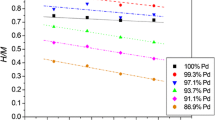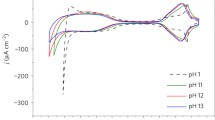Abstract
A decrease in the excess deformation volume (a kind of “imprint” of the system after the stay of hydrogen in Pd) with an increase in the amount of hydrogen introduced into Pd (starting from H : Pd = 0.25) and then removed electrochemically. In parallel, an increase in the electrical conductivity of electrochemically dihydrogenated palladium hydrides by 12% in comparison with the initial samples of pure palladium in a wide temperature range (75–300 K) was recorded. This means that some of the hydrogen in the Pd (about 5.3 × 1015 atoms per sample) passed into a more compressed, highly conductive phase. In this case, an increase in electrical conductivity with respect to pure Pd can occur both due to the formation and propagation of highly conductive regions of palladium hydride and due to electron transfer (percolation, tunneling) between individual nanoclusters of quasi-metallic hydrogen, localized in the region of metal structural defects, namely, in vacancy clusters and inside the cores of edge dislocations, where the highest pressures in the lattice are achievable.

Similar content being viewed by others
REFERENCES
Hydrogen in Metals I: Basic Properties, Alefeld, G. and Völkl, J., Eds., Berlin: Springer, 1978.
Schirber, J.E. and Morosin, B., Phys. Rev. B, 1975, vol. 12, p. 117.
Lomovskoi, V.A., Lyakhov, B.F., Lomovskaya, N.Yu., and Bellyaev, E.G., Prot. Met. Phys. Chem. Surf., 2010, vol. 46, no. 3, p. 375.
Solodkova, L.N., Lyakhov, B.F., Lipson, A.G., and Tsivadze, A.Yu., Prot. Met. Phys. Chem. Surf., 2010, vol. 46, no. 5, p. 524.
Bardyshev, I.I., Lyakhov, B.F., Polukarov, Yu.M., Kotenev, V.A., and Tsivadze, A.Yu., Prot. Met. Phys. Chem. Surf., 2011, vol. 47, no. 5, p. 680.
Drozdov, A.P., Eremets, M.I., Troyan, I.A., Ksenofontov, V., and Shylin, S.I., Nature, 2015, vol. 525, p. 73.
Somayazulu, M., Ahart, M., Mishra, A.K., Geballe, Z.M., Baldini, M., Meng, Y., Struzhkin, V.V., and Hemley, R.J., Phys. Rev. Lett., 2019, vol. 122, p. 027001.
Liu, H., Naumov, I.I., Hoffmann, R., Ashcroft, N.W., and Hemley, R.J., Proc. Natl. Acad. Sci. U.S.A., 2017, vol. 114, p. 6990.
Kawae, T., Inagaki, Y., Wen, S., Hirota, S., Itou, D., and Kimura, T., J. Phys. Soc. Jpn., 2020, vol. 89, p. 051004. https://doi.org/10.7566/JPSJ.89.051004
Ashcroft, N.W., Phys. Rev. Lett., 1968, vol. 11, p. 1748.
Brovman, E.G., Kagan, Yu.A., and Kholas, A.S., Zh. Eksp. Teor. Fiz., 1972, vol. 62, no. 4, p. 1492.
Chachan, H. and Louie, S.G., Phys. Rev. Lett., 1991, vol. 66, p. 64.
Garcia, A., Barbee, T.W., Cohen, M.L., and Silvera, I.F., Europhys. Lett., 1990, vol. 13, p. 355.
Ashcroft, N.W., Phys. Rev. Lett., 2004, vol. 92, p. 187002.
Brodowsky, H., Z. Phys. Chem., 1965, vol. 44, p. 129.
Lipson, A.G., Lyakhov, B.F., Sakov, D.M., and Kuznetsov, V.A., Fiz. Tverd. Tela, 1997, vol. 39, no. 12, p. 2113.
Morozov, A.N. and Sigov, A.S., Usp. Fiz. Nauk, 1994, vol. 164, no. 3, p. 243.
Hydrogen in Metals II: Application-Oriented Properties, Alefeld, G. and Völkl, J., Eds., Berlin: Springer, 1978.
Subramaniam, P.K., Comprehensive Treatise of Electrochemistry, New York: Plenum Press, 1981, vol. 4, p. 411.
Lyakhov, B.F., Bovenko, V.N., Danilov, A.I., Urin, O.V., Molodkina, E.B., Zagorskii, V.Z., Polukarov, Yu.M., and Kudryavtsev, V.N., Russ. J. Electrochem., 1996, vol. 32, no. 5, pp. 528–534.
Lyakhov, B.F., Solodkova, L.N., Anufriev, N.G., Vashchenko, S.V., Bardyshev, I.I., Kotenev, V.A., and Tsivadze, A.Yu., Prot. Met. Phys. Chem. Surf., 2020, vol. 56, no. 5, pp. 923–928.
Lyakhov, B.F., Solodkova, L.N., Vashchenko, S.V., Bardyshev, I.I., Tsivadze, A.Yu., Puryaeva, T.P., and Chernyshev, V.V., Theor. Found. Chem. Eng., 2014, vol. 48, no. 6, pp. 793–798.
Demishev, S.V., Kosichkin, Yu.V., Lyapin, A.S., et al., Pis’ma Zh. Eksp. Teor. Fiz., 1993, vol. 56, no. 1, p. 44.
Lipson, A., Heuser, B.J., Castano, C., Miley, G., Lyakhov, B., and Mitin, A., Phys. Rev. B, 2005, vol. 72, p. 212507.
Lipson, G., et al., Phys. Lett. A, 2005, vol. 339, p. 414.
Hirth, J.P. and Lothe, J., Theory of Dislocations, Malabar, FL: Krieger Publ., 1982.
Tripodi, P., Di Gioacchino, D., and Vinko, J.D., J. Alloys Compd., 2009, vol. 470, pp. L6–L8.
Grant, P.M., Parkin, S.S., Lee, V.Y., et al., Phys. Rev. Lett., 1987, vol. 58, p. 2482.
Kotenev, V.A., Vysotskii, V.V., Averin, A.A., and Tsivadze, A.Yu., Prot. Met. Phys. Chem. Surf., 2016, vol. 52, pp. 454–461.
Author information
Authors and Affiliations
Corresponding author
Rights and permissions
About this article
Cite this article
Lyakhov, B.F., Kotenev, V.A. & Tsivadze, A.Y. On the Mechanism of the Growth of Electronic Conductivity upon Reduction in the Excessive Deformation Volume of a Diluted Palladium–Hydrogen System. Prot Met Phys Chem Surf 58, 65–69 (2022). https://doi.org/10.1134/S2070205121060150
Received:
Revised:
Accepted:
Published:
Issue Date:
DOI: https://doi.org/10.1134/S2070205121060150




